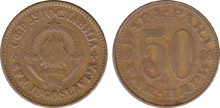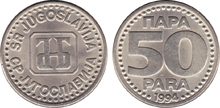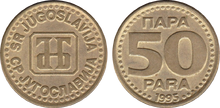- This article is about the Yugoslav coin struck in various types from 1925 to 2000. For Serbian coins of the same denomination, see Serbian 50 para coin (disambiguation).
| 50 para | |
|---|---|

| |
| 2000 coin | |
| General information | |
| Country |
|
| Used by |
|
| Value |
|
| Years |
1925–2000 |
| Measurements and composition | |
| Mass |
|
| Diameter |
|
| Thickness |
|
| Composition |
|
| Appearance | |
| Shape |
round |
| Alignment |
|
| Edge |
|
| Obverse |
See text |
| Reverse |
See text |
| v · d · e | |
The 50 para coin is a circulation piece of Yugoslavia, a former Southeast European country that existed during the 20th and early 21st centuries. It was issued from 1925 to 2000 in 11 major types: one under the Kingdom of Serbs, Croats, and Slovenes; one under the Kingdom of Yugoslavia; one under the Democratic Federal Yugoslavia (DF Yugoslavia); one under the Federal People's Republic of Yugoslavia (FPR Yugoslavia); three under the Socialist Federal Republic of Yugoslavia (SFR Yugoslavia); and four under the the Federal Republic of Yugoslavia (FR Yugoslavia; later known as Serbia and Montenegro).
The first coin of the denomination was issued in 1925, during the early reign of King Alexander I (1888–1934; r. 1921–1934). It was then followed in 1939 by a second piece (dated 1938) of Alexander's son and successor, King Peter II (1923–1970; r. 1934–1945). Both coins initially carried a legal tender face value of 0.50 Yugoslav Serbian dinar in their country of origin. By the time Yugoslavia was invaded and occupied by the Axis powers in the spring of 1941, the piece of Alexander had already been withdrawn and demonetized. The coin of Peter, however, continued to circulate in the Serbian region of occupied Yugoslavia until 1942, holding a value of 0.50 Serbian dinar, or 1⁄500 of a Reichsmark.
The next 50 para piece, part of the post-war Federation dinar, was released in 1945 by the Democratic Federal Yugoslavia. A new piece of the denomination (dated 1953) was then introduced in 1954, during the existence of the short-lived Federal People's Republic of Yugoslavia. Both of the coins initially held a value of 0.50 Federation dinar, but were eventually demonetized. The 1945 piece was withdrawn in 1956, while the 1953 coin remained in circulation until 1968, nearly two years after the Federation dinar was discontinued. During the time period between 1966 and 1968, the later 50 para coin remained valid in Yugoslavia for 0.05 hard dinar.
Two coins of the denomination were introduced by the Socialist Federal Republic of Yugoslavia as part of the hard dinar. The first was released in 1967 (with 1965 dates) and remained in production until 1981. It was then followed in 1982 by a new type, which continued to be manufactured until 1984. Both of these pieces initially carried a value equivalent to 0.50 hard dinar prior to their demonetization at the end of 1985.
In 1990, the hard dinar was replaced by the convertible dinar at a rate of 10,000 to 1. A single 50 para coin, produced from 1990 to 1991, was released under this currency. Carrying a face value of 0.50 convertible dinar, the piece was eventually demonetized in early 1992.
No 50 para coins were manufactured for the short-lived reformed dinar, "1993" dinar, and "1994" dinar. The next was introduced by the Federal Republic of Yugoslavia in 1994 as part of the first series of novi dinar pieces. A similar type of a different composition was then released the following year, in 1995. These two pieces were then followed in 1996 by a redesigned coin, which continued to be produced annually until 1999. The final piece of the denomination was then released in late 2000. The first three coins circulated for a value of 0.50 novi dinar throughout FR Yugoslavia until 1999; from then they were only used in the constituent Republic of Serbia. After the novi dinar was replaced by the Serbian dinar in 2003, the pieces continued to circulate at the same face value under the new currency. The first three were eventually withdrawn at the start of 2006, while the final coin was not withdrawn until 2008, nearly two years after Serbia's independence.
All of the coins were distributed by the National Bank of Yugoslavia (now the National Bank of Serbia) and its precursors, the National Bank of the Kingdom of Yugoslavia and the National Bank of the Kingdom of Serbs, Croats, and Slovenes. With the exception of the 1925 type, which was struck at the mint of the French Coinage Society in Poissy, France, and the Royal Belgian Mint in Brussels, Belgium, each of the pieces was produced at the Institute for Manufacturing Banknotes and Coins (Serbo-Croatian: Zavod za izradu novčanica i kovanog novca) in Belgrade, Yugoslavia (in modern Serbia).
Coins[]
Coins of the Serbian dinar (1925–1938)[]
Coin of Alexander I (1925)[]
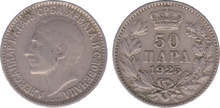
1925 coin
On December 1, 1918, not long after the conclusion of World War I (1914–1918), the Kingdom of Serbia was unified with Montenegro and the unrecognized State of Slovenes, Croats, and Serbs to form the Kingdom of Serbs, Croats, and Slovenes (colloquially known as "Yugoslavia"). Peter I Karađorđević (1844–1921; r. 1918–1921), the previous King of Serbia, was declared monarch of the newly formed nation, and his dynasty, the House of Karađorđević, was established as the country's royal family. After Peter's death in 1921, his second oldest son, Alexander Karađorđević, was proclaimed the next King of the Serbs, Croats, and Slovenes. Upon his accession to the throne, the new king adopted the monarchical name Alexander I (Serbo-Croatian: Aleksandar I).
Because of the change in leadership, in 1925 the National Bank of the Kingdom of Serbs, Croats, and Slovenes authorized the production of a new coin series consisting of denominations of 50 para and 1, 2, and 20 dinara. These were later followed in 1931 and 1932 by new 10, 20, and 50 dinar pieces. With the exception of the first 20 dinar coin, these pieces were intended to be used alongside the 5, 10, and 25 para coins in circulation since 1920. The 50 para piece of the series, struck solely in 1925, was released on September 5 of that year and remained in circulation until August 16, 1940. It was struck under commission at the Poissy Mint in France and the Royal Belgian Mint in Brussels and designed by Henri-Auguste Patey (1855–1930), the Graveur général des monnaies (General Engraver of Coins) at the Monnaie de Paris at the time.
The 50 para piece is composed of a cupronickel alloy of 75 percent copper and 25 percent nickel and measures 2.5 grams in mass, 18 millimeters in diameter, and 1.25 millimeters in thickness. It has coin alignment and a reeded edge, and like most coins, is round in shape. The rims on both sides of the piece are raised and decorated with a dentilated border.
A left-facing bust of Alexander I appears in the center of the obverse. The Cyrillic caption "АЛЕКСАНДАР I. КРАЉ СРБА, ХРВАТА И СЛОВЕНАЦА" (Romanized: Aleksandar I, Kralj Srba, Hrvata, i Slovenaca), which translates from Serbo-Croatian as "Alexander I, King of the Serbs, Croats, and Slovenes", partially encircles the illustration, extending clockwise from the piece's lower left to lower right peripheries. Engraved at below Alexander's likeness in small print is the "A.PATEY" signature of the artist.
The face value "50 ПАРА" (Romanized: 50 Para) is inscribed on two lines in the middle of the reverse, while the Gregorian date of minting, "1925", is written in smaller font on a new line below. A decorative wreath consisting of two tied branches extends along much of the coin's lower boundary, traveling up both sides of the reverse from the bottom center of the piece. The remainder of the rim at the top of the reverse is occupied by the Karađorđević dynastic crown, a symbol of the Yugoslav monarchy. On coins struck in Poissy, a small thunderbolt mint mark is additionally included between the left branch in the wreath and the rim at about the seven o'clock position.
A total of 49,500,000 examples of the coin, all business strikes, were manufactured during a single year of production. Of these, a reported 25,000,000 were struck in Poissy and 24,500,000 were minted in Brussels.
Trial strikes and errors[]
Brass, copper, nickel, and silver trial strikes and cupronickel and nickel-bronze coins from Poissy bearing the word "ESSAI" on the reverse are known to exist. A uniface obverse trial of the 1925 piece is also documented.
A coin struck on a larger 21.5-millimeter planchet is additionally reported, as is a brockage error showing a mirror image of the reverse pressed into the obverse.
Coin of Peter II (1938)[]
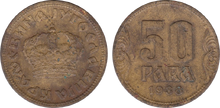
1938 coin
In 1929, in response to growing separatism in Yugoslavia, King Alexander I unpopularly abolished the country's first constitution, prorogued the Yugoslav Parliament, and established a personal dictatorship. During the same year, he also officially renamed the Kingdom of Serbs, Croats, and Slovenes to the Kingdom of Yugoslavia and redefined the nation's internal divisions. From then, Alexander ruled absolutely until his assassination in late 1934.
Shortly after Alexander's death, Peter II Karađorđević, the deceased monarch's oldest son, became the next King of Yugoslavia. However, being only 11 years old at the start of his reign, Peter was considered too young to assume the monarchical responsibilities of the kingdom. Because of this, Prince Paul Karađorđević, a cousin of King Alexander, was appointed to govern in Peter's place as regent until the young king came of age to rule.
In spite of opposition from Peter and his advisers, in 1941, Prime Minister Dragiša Cvetković (1893–1969; i.o. 1939–1941), with the support of Prince Paul, signed the Tripartite Pact, thereby aligning Yugoslavia with the Axis powers in World War II. In response, military conspirators launched a successful coup d'état against the government of Cvetković and Paul, and the Tripartite Pact was rejected. Although this initiative finally allowed the 17-year-old Peter to assume monarchical power, it inevitably led to the Axis invasion and subsequent occupation of Yugoslavia later that year.
In 1938, during the middle of Peter's reign, the National Bank of the Kingdom of Yugoslavia called for the production of a new coin series consisting of denominations of 25 and 50 para, and 1, 2, 10, 20, and 50 dinara. Although dated 1938, the 50 para piece of the series was not released until August 16, 1939. From then, it circulated throughout Yugoslavia until the Axis occupation in the spring of 1941. The piece then continued to be used in areas of German occupied Serbia for 0.50 Serbian dinar, or 1⁄500 of a Reichsmark, until October 26, 1942. It was struck at the Institute for Manufacturing Banknotes and Coins in Belgrade. Its designs, drafted by Dalmatian sculptor Frano Meneghello Dinčić (1900–1986), were the result of a coin design competition held around 1937 by the National Bank of the Kingdom of Yugoslavia.
The 50 para piece is composed of an aluminum-bronze alloy of 91 percent copper and 9 percent aluminum and measures 2 grams in mass, 18 millimeters in diameter, and 1.25 millimeters in thickness. It has coin alignment and a plain edge, and is round in shape. Both of the piece's rims are raised, and that of the obverse is decorated with a beaded border. The upper and lower peripheries on the reverse are also embellished by a beaded boundary, and the left and right rims are decorated with ornamental designs.
The Karađorđević dynastic crown is displayed in the middle of the obverse. Surrounding it, extending clockwise from the coin's lower periphery, is the Cyrillic caption "КРАЉЕВИНА ЈУГОСЛАВИЈА" (Romanized: Kraljevina Jugoslavija), which translates from Serbo-Croatian as "Kingdom of Yugoslavia".
The face value "50 PARA" is featured on two lines in the center of the reverse, the numeral displayed in a noticeably larger font than the following word. Written in even smaller print below "PARA" is the Gregorian date of minting, "1938".
A total of 100,000,000 examples of the coin were manufactured during a single year of production. Although proofs of the other lower valued 1938 coins (25 para to 2 dinara) were minted, the 50 para piece was only struck with a standard finish.
Error coins[]
An error variety of the 1938 piece with medallic alignment is known to exist.
Coins of the Federation dinar (1945–1953)[]
First circulation coin (1945)[]
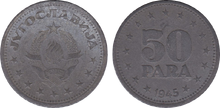
1945 coin
During the first half of World War II, two prominent anti-Axis resistance groups emerged in Yugoslavia – the communist Partisans led by Josip Broz Tito (1892–1980) and the royalist Chetniks commanded by Dragoljub "Draža" Mihailović (1893–1946). Although the two factions initially cooperated, ideological differences caused Mihailović's Chetniks to eventually align with the Axis, leaving the Partisans as the only major anti-Axis resistance group active in Yugoslavia. On November 29, 1943, the Partisans established the Democratic Federal Yugoslavia (DF Yugoslavia) through a session of the Anti-Fascist Council for the National Liberation of Yugoslavia (AVNOJ). This government, which maintained control over Partisan-held territories during World War II, remained the de facto government of liberated Yugoslavia until November 29, 1945, when the Federal People's Republic of Yugoslavia was formed.
During mid to late 1945, the newly renamed National Bank of Yugoslavia introduced a new series of coins in denominations of 50 para and 1, 2, and 5 dinara. As part of the Federation dinar, these new pieces were intended to replace the Yugoslav coins issued by the monarchy before the war. All four were struck at the Institute for Manufacturing Banknotes and Coins in Belgrade, and their designs are of uncertain authorship. The 50 para piece of the series, which was struck solely in 1945, was released on August 6, 1945. It remained in circulation until its demonetization on December 31, 1956.
The 50 para coin is composed of a 97.5-percent zinc alloy and measures 2 grams in mass, 18 millimeters in diameter, and 1.4 millimeters in thickness. It has coin alignment and a reeded edge, and is round in shape. Both of the piece's rims are raised and decorated with beaded border.
Featured in the center of the obverse is the emblem of DF Yugoslavia – which consists of five lit torches surrounded by ears of wheat. The wheat is bounded by a ribbon bearing the date "29·XI·1943", and a red star symbolizing communism appears above the entire emblem. Printed clockwise along the rim above is the Serbo-Croatian name of Yugoslavia, rendered in Cyrillic as "ЈУГОСЛАВИЈА" (Romanized: Jugoslavija). The remainder of the rim at the bottom of the obverse is occupied by nine five-pointed stars.
The face value "50 PARA" appears on two lines in the middle of the reverse, the numeral inscribed in significantly larger print than the following word. Engraved counterclockwise at the piece's lower boundary is the Gregorian date of minting, "1945". The remainder of the rim is occupied by fifteen five-pointed stars.
A reported 65,440,000 examples of the coin were produced. Only business strikes of this particular type are known to exist.
Trial strikes and errors[]
A small number of aluminum and brass trial strikes of the 1945 piece were manufactured.
Notable error varieties include pieces with irregular die axes, such as a coin with medallic instead of coin alignment, and a brockage showing a mirror image of the obverse pressed into the reverse.
Second circulation coin (1953)[]
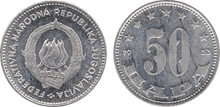
1953 coin
The Federal People's Republic of Yugoslavia, a communist republic, was proclaimed on November 29, 1945, and formally established with the promulgation of a new constitution on January 31, 1946. This name continued to be used until 1963, when the country was renamed to the Socialist Federal Republic of Yugoslavia. Josip Broz Tito, the commander of the Partisans during World War II, held leadership positions under both governments, serving as prime minister, or head of government of FPR Yugoslavia from 1945 to 1963, and as president, or head of state of FPR and SFR Yugoslavia from 1953 to his death in 1980.
From 1953 to 1955, the National Bank of Yugoslavia called for the production of a new coin series for the Federation dinar. Consisting of denominations of 50 para and 1, 2, 5, 10, 20, and 50 dinara, the entire series was struck at the Institute for Manufacturing Banknotes and Coins in Belgrade. The 50 para piece, although dated 1953, was not released until September 1, 1954. From then, it circulated for a value of 1.00 Federation dinar until December 31, 1965. After this date, the coin then remained in circulation for 0.005 hard dinar before being demonetized on May 31, 1968.
The 50 para piece is composed of a 99-percent aluminum alloy and measures 0.62 grams in mass, 17.4 millimeters in diameter, and 1.2 millimeters in thickness. It has medallic alignment and a plain edge, and is round in shape. Both of the coin's rims are raised and decorated with a beaded border.
Featured in the center of the obverse is the emblem of FPR Yugoslavia – which consists of five lit torches (representing PR Croatia, PR Macedonia, PR Montenegro, PR Serbia, and PR Slovenia) surrounded by ears of wheat. A ribbon bearing the date "29·XI·1943" bounds the wheat, and a red star symbolizing communism is illustrated above the entire emblem. Surrounding the emblem is the full Serbo-Croatian name of FPR Yugoslavia, "FEDERATIVNA NARODNA REPUBLIKA JUGOSLAVIJA", which extends clockwise from the coin's lower left to lower right peripheries. The beginning and end of the inscription are separated from one another by a group of four diamonds at the bottom of the obverse.
The face value "50 ПАРА" (Romanized: 50 Para) is written in a decorative font in the middle of the reverse. The numeral in the value is engraved horizontally in the center of the piece, while the following word is inscribed in noticeably smaller print at the lower rim. Engraved in the middle of the coin is the Gregorian date "1953", the first two digits (19) separated from the last two (53) by the "50" in the value. The remainder of the coin's rim at the top of the obverse is occupied by seven five-pointed stars.
A total of 60,036,000 examples of the 1953 coin were produced, all with a standard finish. A small number of uncirculated pieces were distributed in official mint sets by the National Bank of Yugoslavia.
1965 pattern coin[]
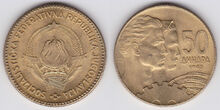
A 50 dinar piece of 1963
After FPR Yugoslavia became SFR Yugoslavia in 1963, the 1953–1955 series of coins (excluding the 50 para piece) was modified to include the country's new name and national emblem. Two separate design schemes were used for both series, the lower valued coins having a more generic appearance and the higher valued 10, 20, and 50 dinar coins utilizing more appealing designs. Pieces of the latter group were quite popular, and remained in circulation for 1⁄100 of their value under the hard dinar until December 31, 1985, several years after the discontinuation of the Federation dinar in 1965.
Around 1965, the Institute for Manufacturing Banknotes and Coins in Belgrade struck an unissued 50 para pattern coin that reused the designs of the 1955 and 1963 Yugoslav 50 dinar pieces. For unknown reasons, this design was ultimately rejected in favor of a new design drafted by Serbian sculptor Dragomir Mileusnić (1943–), which was eventually utilized on the first 50 para coin of the Yugoslav hard dinar.
The piece is composed of aluminum-bronze or brass and measures 6 grams in mass and 25.5 millimeters in diameter. Like most coins, it is round in shape. The rims of both sides of the piece are raised, and that of the obverse is decorated with a beaded border.
Displayed in the middle of the obverse is the emblem of SFR Yugoslavia, which is similar to that of FPR Yugoslavia, but features six torches (representing SR Bosnia and Herzegovina, SR Croatia, SR Macedonia, SR Montenegro, SR Serbia, SR Slovenia) instead of five. This illustration is surrounded by the full Serbo-Croatian of SFR Yugoslavia, "SOCIJALISTIČKA FEDERATIVNA REPUBLIKA JUGOSLAVIJA", which extends clockwise from the coin's lower left to lower right rims. The beginning and end of this inscription are separated from one another by a group of four diamonds at the bottom of the obverse.
Right-facing likenesses of a Yugoslav man and woman appear at the right side of the reverse, the man displayed in the foreground and the woman illustrated in the midground. Engraved to the lower right are a gear and four ears of wheat, which respectively represent industry and agriculture, and written horizontally to the upper right is the face value "50 ПАРА" (Romanized: 50 Para). The numeral and word in the face value are separated onto their own lines, the former displayed in a significantly larger font than the latter. Inscribed in smaller print below "ПАРА" (para) is the Gregorian date of minting, "1965".
The total mintage of the 1965 pattern is currently unknown. In the 2011 edition of his Coins and Banknotes of Yugoslavia, Slovenia, Croatia, Bosnia and Herzegovina, Serbia, Montenegro and Macedonia, numismatic author Zlatko Viščević lists the pattern as an extremely rare piece.
Coins of the hard dinar (1965–1984)[]
First circulation coin (1965–1981)[]
During the 1950s and early 1960s, high levels of inflation continued to noticeably decrease the purchasing power of the Federation dinar. In response to this problem, on January 1, 1966, the National Bank of Yugoslavia revalued the dinar at a rate of 100 to 1, creating what became known as the Yugoslav hard dinar. The first series of coins for this currency, which consisted of denominations of 5, 10, 20, and 50 para and 1 dinar, was minted late in 1965 and into 1966, but was not fully released until 1967. All of the pieces were struck at the Institute for Manufacturing Banknotes and Coins in Belgrade and designed by sculptor Dragomir Mileusnić. The 50 para coin, which was struck from 1965 to 1981, was first released on February 15, 1967. It remained in circulation until its demonetization on December 31, 1985.
The piece is composed of a brass alloy of 85 percent copper, 14.5 percent zinc, and 0.5 percent aluminum, and measures 6 grams in mass, 25.5 millimeters in diameter, and 1.5 millimeters in thickness. It has medallic alignment and a reeded edge, and is round in shape. Both of the coin's rims are raised. The obverse's rim is decorated with a dentilated border, while the reverse's is adorned with a beaded boundary.
The emblem of SFR Yugoslavia is displayed in the center of the obverse. Printed clockwise along the rim above is the Cyrillic legend "СФР ЈУГОСЛАВИЈА", which is abbreviated for the Serbo-Croatian and Macedonian name of SFR Yugoslavia, "Социјалистичка Федеративна Република Југославија". Its Latin equivalent, "SFR JUGOSLAVIJA", which is shortened for the Serbo-Croatian Socijalistička Federativna Republika Jugoslavija and Slovene Socialistična federativna republika Jugoslavija, is engraved in the opposite direction at the coin's lower periphery. The two inscriptions are separated from one another by two groups of four diamonds, one at each side of the obverse.
Written in a large decorative font in the middle of the obverse is the numeral "50". On coins minted from 1965 to early 1979, the hole in the digit "0" is significantly narrower than it is on later pieces. Most coin catalogs, including works by numismatic author Ranko Mandić and the Standard Catalog of World Coins, mention these two varieties and give them separate catalog numbers. Printed clockwise along the rim above are the Serbo-Croatian "ПАРА" and "PARA", and written in the opposite direction at the periphery below are the Slovene "PAR" and Macedonian "ПАРИ" (Romanized: Pari). A circular point separates the Serbo-Croatian inscriptions at the top of the piece, and another divides the Slovene and Macedonian translations at the bottom. The Gregorian date of minting is engraved horizontally in the middle of the reverse, its first two digits separated from its last two by the "50". According to the Standard Catalog of World Coins, two varieties of the date on 1978 coins are known. The serif of the "7" in one variety is more "rectangular", while the other appears to be "sharper".
According to works by Ranko Mandić, approximately 225,820,000 examples of the coin were produced from 1965 to 1981, including pieces with standard and proof finishes. The Standard Catalog of World Coins only includes quantities for pieces dated 1973 to 1981, reporting a total mintage of 181,063,000 pieces during this period. It does not mention the existence of any proofs, and presents mintage figures that slightly differ from Mandić's. Both sources, however, indicate that a handful of uncirculated pieces were sold in official mint sets by the National Bank of Yugoslavia.
| Mintages | ||
|---|---|---|
| Year | Variety | Mintage |
| 1965 | Narrow "0" | 44,850,000 (Mandić) Unknown (SCWC) |
| 1973 | 23,739,000 | |
| 1974 | 33,000 | |
| 1975 | 10,187,000 (Mandić) 10,220,000 (SCWC) | |
| 1976 | 8,438,000 | |
| 1977 | 17,864,000 | |
| 1977 Proof | Unknown (Mandić) | |
| 1978 | Narrow "0" Rectangular serif in "7" |
40,117,000 (Mandić) 40,177,000 (SCWC) |
| Narrow "0" Sharp serif in "7" | ||
| 1979 | Narrow "0" | 3,021,000 |
| Wide "0" | 12,278,000 | |
| 1980 | 24,974,000 | |
| 1981 | 40,319,000 | |
| Total | ~225,820,000 (Mandić) > 181,063,000 (SCWC) | |
Trial strikes and errors[]
Bronze trial strikes of the coin were evidently made in 1974 and 1978, and a copper off-metal strike was manufactured in 1977.
An uncommon error coin from 1965 and 1980 uses coin alignment instead of medallic. Other unusual varieties include pieces (dated 1965, 1978, and 1979) struck on the brass planchets of contemporary 10 para pieces and others (dated 1965, 1973, 1974, and 1980) minted on the flans of 20 para coins. Because these planchets respectively measure 21 and 23.2 millimeters in diameter, compared to the 25.5-millimeter diameter of a standard 50 para piece, some of the designs on both sides are cut off.
1978 pattern coins[]
Evidently, the National Bank of Yugoslavia planned a redesign of Yugoslav coinage around 1978, as an unissued series of pieces in denominations of 25 and 50 para and 1, 2, 5, and 10 dinara was struck that year at the Institute for Manufacturing Banknotes and Coins. All of the pieces were likely designed by Dragomir Mileusnić, the artist of various Yugoslav coins of the time period.
The 50 para piece was struck in at least three types. This includes a single cupronickel type measuring 2.8 grams in mass and 20 millimeters in diameter and two brass types, one with a mass of 2.5 grams and diameter of 18 millimeters and another with a mass of 2.9 grams and a diameter of 19.7 millimeters. Regardless of the type, the 1978 patterns have medallic alignment and a reeded edge, and are round in shape. The rims of both the obverse and reverse are raised and undecorated.
The emblem of SFR Yugoslavia appears inside a circular beaded border in the center of the obverse. Inscribed above, extending clockwise from the left to right rims, is the Cyrillic legend "СФР ЈУГОСЛАВИЈА". Its Latin equivalent, "SFR JUGOSLAVIJA", is written in the same direction below, traveling from the coin's right to left peripheries. These inscriptions are separated from one another by two small diamonds, one at each side of the obverse.
A large numeral "50" is engraved in the middle of the reverse, superimposing eight lines of the word para in Serbo-Croatian, Slovene, and Macedonian. In order, the words are written as "ПАРА", "PARA", "PAR", and "ПАРИ" (pari), and are separated from one another by small circular points. The Gregorian date "1978" is additionally printed at the end of the first line, its first two digits partially overlapped by the "0" in the "50". Similarly, an "M" mark, likely identifying the designer, is included at the end of the second line, and is also partially superimposed by the "0".
The total mintages of the 1978 patterns are currently unknown. They are currently documented in certain catalogs of Yugoslav and post-Yugoslav currency, including Ranko Mandić's Catalog of Coins of Yugoslavia and Yugoslavian Lands 1700-1994 and Zlatko Viščević's Coins and Banknotes of Yugoslavia, Slovenia, Croatia, Bosnia and Herzegovina, Montenegro and Macedonia. As of its 2017 publication, the popular Standard Catalog of World Coins does not include listings for any of the three types.
| Varieties | |||||
|---|---|---|---|---|---|
| No. | Composition | Mass | Diameter | References | |
| 1 | Cupronickel | 2.8 g | 20 mm | R144 (Mandić) S124 (Viščević) | |
| 2 | Brass | 2.5 g | 18 mm | R145 (Mandić) S125 (Viščević) | |
| 3 | 2.9 g | 19.7 mm | R146 (Mandić) S126 (Viščević) | ||
Second circulation coin (1982–1984)[]
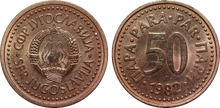
1982 coin
During the early 1980s, the purchasing power of the hard dinar continued to fall as a result of high inflation. Consequently, many of the small denomination coins in use during the period, including the 5, 10, and 20 para pieces, began to disappear from circulation. In 1982, the National Bank of Yugoslavia discontinued these lower valued coins and introduced a new series in denominations of 25 and 50 para and 1, 2, 5, and 10 dinara. Three years later in 1985, these were joined by new 20, 50, and 100 dinar pieces. All of the coins of this series were struck at the Institute for Manufacturing Banknotes and Coins in Belgrade and designed by sculptor Dragomir Mileusnić. The 50 para piece, which was produced annually from 1982 to 1984, was first released on July 15, 1982, and remained in circulation until December 31, 1985.
The 50 para coin is composed of a brass alloy of 94.5 percent copper, 5 percent zinc, and 0.5 percent manganese and measures 2.8 grams in mass, 19 millimeters in diameter, and 1.65 millimeters in diameter. It has medallic alignment and a plain edge, and is round in shape. Both of the piece's rims are raised and decorated with a beaded border.
The emblem of SFR Yugoslavia is displayed in the center of the obverse, the Cyrillic legend "СФР ЈУГОСЛАВИЈА" inscribed clockwise along the rim above and its Latin equivalent, "SFR JUGOSLAVIJA", engraved in the opposite direction at the periphery below. These texts are separated from one another by two small diamonds, one at each side of the obverse.
A large numeral "50" is featured in the middle of the obverse. Extending clockwise from the coin's lower left to lower right peripheries are four translations of the word para – the Serbo-Croatian "ПАРА" and "PARA", Slovene "PAR", and Macedonian "ПАРИ" (pari). They are separated from one another and the Gregorian date of minting, which is printed in the opposite direction at the coin's lower rim, by small circular points.
Over three consecutive years of production, a total of 211,326,000 examples of the coin were manufactured, all with a standard finish. Of these, a small number of uncirculated pieces were distributed in official mint sets by the National Bank of Yugoslavia. Reportedly, a small percentage of the 1984 pieces were released into circulation; the remaining coins are believed to have been melted down.
| Mintages | |
|---|---|
| Year | Mintage |
| 1982 | 79,584,000 |
| 1983 | 72,100,000 |
| 1984 | 59,642,000 |
| Total | 211,326,000 |
Trial strikes[]
Brass trial strikes of the coin dated 1982 and 1983 are known to exist.
Coins of the convertible dinar (1990–1991)[]
Circulation coin (1990–1991)[]
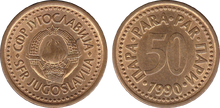
1990 coin
High inflation continued to affect Yugoslavia into the late 1980s, and eventually culminated in 1989 with a brief period of hyperinflation. In response to this problem, the National Bank of Yugoslavia revalued Yugoslavia's currency on January 1, 1990, creating what became known as the Yugoslav convertible dinar. A few days later, on January 3, the first series of coins for the new currency, consisting of denominations of 10, 20, and 50 para and 1, 2, and 5 dinara, was released into circulation. All seven pieces were struck at the Institute for Manufacturing Banknotes and Coins in Belgrade and designed by Dragomir Mileusnić. The 50 para coin, which was minted from 1990 to 1991, circulated until March 1, 1992, a few months before the introduction of the reformed dinar on July 1.
The 50 para piece is composed of a brass alloy of 85 percent copper and 15 percent zinc and measures 4.68 grams in mass, 22 millimeters in diameter, and 1.65 millimeters in thickness. It has medallic alignment and a plain edge, and is round in shape. Both of the coin's rims are raised and decorated with a beaded border.
The coin's designs are very similar to those of the 1982–1984 piece. The emblem of SFR Yugoslavia appears in the middle of the obverse, the Cyrillic legend "СФР ЈУГОСЛАВИЈА" engraved clockwise along the rim above and its Latin equivalent, "SFR JUGOSLAVIJA", inscribed in the opposite direction at the periphery below. These texts are separated from one another by two small diamonds, one at each side of the obverse.
The numeral "50" is displayed in the center of the obverse. It is partially surrounded by four translations of the word para – the Serbo-Croatian "ПАРА" and "PARA", Slovene "PAR", and Macedonian "ПАРИ" (pari) – which travel clockwise from the coin's lower left to lower right peripheries. They are separated from one another and the Gregorian date of minting, which is printed in the opposite direction at the lower rim, by small circular points.
A total of 216,025,000 examples of the coin were struck during two years of production, each with a standard finish. Of these, a small number of uncirculated examples were sold in official mint sets by the National Bank of Yugoslavia.
| Mintages | |
|---|---|
| Year | Mintage |
| 1990 | 173,873,000 |
| 1991 | 42,152,000 |
| Total | 216,025,000 |
Trial strikes[]
Trial strikes of the coin in brass, copper, and nickel were minted in 1990, and another off-metal strike in zinc was also made in 1991.
Coins of the novi dinar (1994–2000)[]
First and second circulation coins (1994–1995)[]
During the 1990s, Yugoslavia faced a series of dramatic political crises. From 1991 to 1992, four of the six constituent republics of SFR Yugoslavia broke away from the country, becoming what are now the independent nations of Bosnia and Herzegovina, Croatia, Macedonia, and Slovenia. As a result, the remaining republics of Serbia and Montenegro united to form the Federal Republic of Yugoslavia (FR Yugoslavia), which later became known as the State Union of Serbia and Montenegro in 2003. In addition to the breakup of Yugoslavia, unresolved ethnic tensions resulted in a series of wars in the region during the period.
Economic problems also affected Yugoslavia during the time period. Despite the revaluation attempt undertaken by the National Bank of Yugoslavia in 1990, another period of hyperinflation in Yugoslavia began in April 1992. The Yugoslav dinar was revalued three more times from then until 1994, but none of these efforts were ultimately successful. On January 24, 1994, in one last attempt at countering hyperinflation, the novi dinar was introduced. It, unlike previous incarnations of Yugoslavia's currency, was not revalued but pegged at par to the Deutsche Mark, one of the world's most stable currencies at the time. Initially volatile, the new dinar began stabilizing around 1999. It was replaced in Montenegro by the Deutsche Mark later that year and in Serbia by the Serbian dinar in 2003.
The first series of coins of the novi dinar, consisting of denominations of 1, 5, 10, and 50 para and 1 dinar, was introduced by the National Bank of Yugoslavia in 1994. Of these, the 5, 10, and 50 para pieces were struck again in different metals in 1995. All of the coins were minted at the Institute for Manufacturing Banknotes and Coins in Belgrade, and their designs are of uncertain authorship. The first 50 para piece was released on January 24, 1994, while the second was put into circulation on November 24, 1995. Both continued to be used for a value of 0.50 novi dinar until 2003, and then for 0.50 Serbian dinar until their demonetization on January 1, 2006.
The 1994 coin is composed of a copper-nickel-zinc alloy of 70 percent copper, 18 percent zinc, and 12 percent nickel and measures 3.79 grams in mass, 20 millimeters in diameter, and 1.65 millimeters in thickness. In contrast, the 1995 piece is made of a brass alloy of 75 percent copper, 23 percent zinc, and 2 percent nickel and is slightly larger, measuring 4.12 grams in mass, 21 millimeters in diameter, and 1.75 millimeters in thickness. Both have medallic alignment and a plain edge, and are round in shape. The rims of both sides of the two coins are raised and decorated with a beaded border.
The emblem of the National Bank of Yugoslavia – which consists of a monogram inside a solid rectangular boundary – is displayed in the middle of the obverse. In the depiction, the letters comprising the monogram, "НБЈ", are abbreviated for "Народна банка Југославије" (Romanized: Narodna banka Jugoslavije), the name of Yugoslavia's central bank in Serbo-Croatian. Printed clockwise along the rim above is the Latin "SR JUGOSLAVIJA", an abbreviation of the Serbo-Croatian Savezna Republika Jugoslavija (English: "Federal Republic of Yugoslavia"). Its Cyrillic equivalent, "СР JУГОСЛАВИJА", which is shortened for "Савезна Република Југославија", is inscribed below the emblem, extending in the opposite direction at the coin's lower rim.
A large numeral "50" appears in the center of the reverse, the Cyrillic "ПАРА" inscribed horizontally above in smaller print and the Latin "PARA" written below in the same size font. Engraved counterclockwise at the periphery below the word "PARA" is the Gregorian date of minting, which interrupts the rim's beaded border.
A total of 45,013,000 examples of the 1994 piece and 19,193,000 specimens of the 1995 coin were produced. Only business strikes of both types are reported to exist.
Third circulation coin (1996–1999)[]
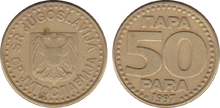
1997 coin
In 1996, the National Bank of Yugoslavia issued a series of redesigned 10 and 50 para and 1 dinar coins. A 5 para piece was also struck during the same year, but only differed in terms of measurements, not design. All of these coins were struck at the Institute for Manufacturing Banknotes and Coins in Belgrade, and their designs are of uncertain authorship. The 50 para piece of the series, which was struck annually from 1996 to 1999, was initially released on August 9, 1996. It continued to circulate for a value of 0.50 novi dinar until 2003, and then for a value of 0.50 Serbian dinar until January 1, 2006.
The coin is composed of a brass alloy of 75 percent copper, 23 percent zinc, and 2 percent nickel and measures 4.12 grams in mass, 21 millimeters in diameter, and 1.75 millimeters in thickness. It has medallic alignment and a plain edge, and is round in shape. Both of the piece's rims are raised and decorated with a beaded border.
Displayed in the middle of the obverse is the coat of arms of FR Yugoslavia – which consists of an escutcheon containing a double-headed eagle in its center. Superimposing the eagle's breast is a shield containing symbols representative of the Serbs and Montenegrins. The Latin "SR JUGOSLAVIJA" is printed clockwise along the rim above, while its Cyrillic equivalent, "СР JУГОСЛАВИJА", is inscribed in the opposite direction at the periphery below.
The reverse is nearly identical to that of the 1994 and 1995 circulation pieces. A large numeral "50" is featured in the center, the Cyrillic "ПАРА" inscribed horizontally above and the Latin "PARA" engraved in the same direction below. Written counterclockwise in small print below the word "PARA" is the Gregorian date of minting, which interrupts the rim's reeded border.
A total of 56,452,000 examples of the coin were produced over four years of production. Only business strikes of this particular type are known to exist.
| Mintages | |
|---|---|
| Year | Mintage |
| 1996 | 3,520,000 |
| 1997 | 14,742,000 |
| 1998 | 20,050,000 |
| 1999 | 18,140,000 |
| Total | 56,452,000 |
Fourth circulation coin (2000)[]
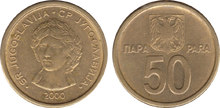
2000 coin
In 2000, the last coin series attributed to Yugoslavia was introduced by the nation's central bank. Consisting of denominations of 50 para and 1, 2, and 5 dinara, the series was minted at the Institute for Manufacturing Banknotes and Coins in Belgrade. The 50 para piece, which was struck solely in 2000, entered circulation on December 15 of that year. It continued to be used for a value of 0.50 novi dinar until 2003, and then for 0.50 Serbian dinar until its demonetization on January 1, 2008.
The coin is composed of a brass alloy of 75 percent copper, 23 percent zinc, and 2 percent nickel and measures 3.26 grams in mass, 18 millimeters in diameter, and 1.85 millimeters in thickness. It has coin alignment and a plain edge, and is round in shape. Both of the piece's rims are raised and undecorated.
"Srbija", an allegorical bust of Mother Serbia, is shown facing ¾ left in the center of the coin's obverse. This sculpture, designed in 1904 by Serbian artist Đorđe Jovanović (1861–1953), was initially intended for the Monument to the Kosovo Heroes in Kruševac. It was later acquired by the National Bank of Yugoslavia (now the National Bank of Serbia), and currently resides in the vestibule of the older part of the National Bank building. Printed to the left of the bust, extending clockwise along the rim, is the Latin inscription "SR JUGOSLAVIJA". Its Cyrillic equivalent, "СР JУГОСЛАВИJА", is written in the same direction at the coin's right periphery, separated from the Latin by a small circular point at the top of the obverse. An additional two points also appear on the coin before the Latin inscription and after the Cyrillic text. The Gregorian date of minting, "2000", is printed horizontally below the bust.
The coat of arms of FR Yugoslavia is illustrated at the top center of the reverse, the numeral "50" engraved horizontally below in large print. Written in a smaller font to the left of the arms' base is the Cyrillic word "ПАРА", and inscribed in the same font to the right is its Latin equivalent, "PARA".
A total of 23,821,000 examples of the coin were manufactured, each with a standard finish. Of these, a small number of uncirculated pieces were distributed in official mint sets by the National Bank of Yugoslavia.
References[]
| Yugoslav dinar | |
|---|---|
| Banknotes | ¼ D • ½ D • 1 D • 2 D • 5 D • 10 D • 20 D • 25 D • 50 D • 100 D • 200 D • 500 D • 1,000 D • 5,000 D • 10,000 D • 20,000 D • 50,000 D • 100,000 D • 500,000 D • 1,000,000 D • 2,000,000 D • 5,000,000 D • 10,000,000 D • 50,000,000 D • 100,000,000 D • 500,000,000 D • 1,000,000,000 D • 5,000,000,000 D • 10,000,000,000 D • 50,000,000,000 D • 500,000,000,000 D |
| Coins | 1 p • 5 p • 10 p • 20 p • 25 p • 50 p • 1 D • 2 D • 5 D • 10 D • 20 D • 50 D • 100 D • 150 D • 200 D • 250 D • 300 D • 350 D • 400 D • 500 D • 600 D • 1,000 D • 1,500 D • 2,000 D • 2,500 D • 3,000 D • 5,000 D • 6,000 D • 10,000 D • 20,000 D • 40,000 D • 50,000 D • 100,000 D • 2,000,000 D 1 Dk • 4 Dk • 8 Dk • 12 Dk |
| Miscellaneous | Dinar • Hyperinflation • Institute for Manufacturing Banknotes and Coins • Languages and currency • National Bank of Yugoslavia • Para • Yugoslav leaders on currency • Yugoslav mint sets • Yugoslav proof sets |
Template:Serbian dinar


